Road dust can be cleaned up or bound to the road surface, but more knowledge is needed to determine which approach is more effective. Project Nordust is consequently starting as a Nordic cooperative initiative in which researchers from Sweden, Iceland, Finland, and Norway will work together to fill our knowledge gaps.
Nordust brings together Nordic expertise to advance our understanding of road dust. This cooperative effort will study the nature of the actual dust emission processes and how they affect the concentration of inhalable particles (i.e., PM10 and PM2.5) in the air. The initiative will perform field and laboratory tests as well as disseminate knowledge.
“The best thing about the project is that we’ll have a common cooperative effort. We’ve been working separately for a long time, but now the degree of coordination and sharing will be enhanced”, says Swedish Road and National Transport Research Institute (VTI) researcher Mats Gustafsson.
Particles are formed
Coarse airborne particles arise partly from road wear by studded tyres and partly from winter road maintenance when the roads are sanded. The sand can be ground down to form dust particles. Another problem arises when pedestrian and bicycle paths are sanded, as some of the sand ultimately ends up on the roads, where it can contribute to dust particle formation. Both laboratory testing and field measurements from earlier research confirm that studded tyres are a major source of the dust particles that form in cities. Additional sources of road dust include construction work and dust from surrounding land and unbound roads.
Levels of PM10 and PM2.5 in the air are regulated by EU limit values, and the limit value for PM10 is exceeded in many Nordic cities. Numerous steps have been taken to address this problem. Bans and levies on studded tyres have been used in Sweden and Norway. Various methods for preventing already-formed road dust from eddying up into the air have been used as well. The primary methods used for this are dust binding and cleaning.
Same measurement methods
Another objective of the Nordust research project is to make measurements in a consistent manner, so that data from different countries can be compared.
“To accomplish thus, the same methods need to be used, and both Norway and Finland have shown interest in using the same type of road dust sampler that VTI has developed in Sweden, a so-called wet dust sampler (WDS). Finland, for example, has already ordered one that we will be building for them”, says Gustafsson.
The results will provide researchers with information on, for example, how the quantity and distribution of road dust in the street environment are affected by traffic, precipitation, and various types of remedial measures.
“This knowledge is needed to improve our understanding of the dust emission processes, making it possible to derive new correlations that can be used in modelling road dust emissions”, says Gustafsson.
Nordust is funded by the Swedish Transport Administration, the Norwegian Public Roads Administration, the Finnish Transport Agency, and the The Icelandic Road and Coastal Administration through the Nordic road administration’s cooperative research body, NordFoU.
Facts
Airborne particles are a form of air pollution consisting of small fragments of material – particulate matter (PM) – in the air. PM10 designates the mass concentration of airborne particles smaller than 10 micrometers. Particles smaller than 10 micrometers can pass into the lungs and are linked to diseases of the respiratory tract and cardiovascular system.
 Contact:
Contact:
Mats Gustafsson, Researcher
mats.gustafsson@vti.se
VTI, Sweden







Follow us: